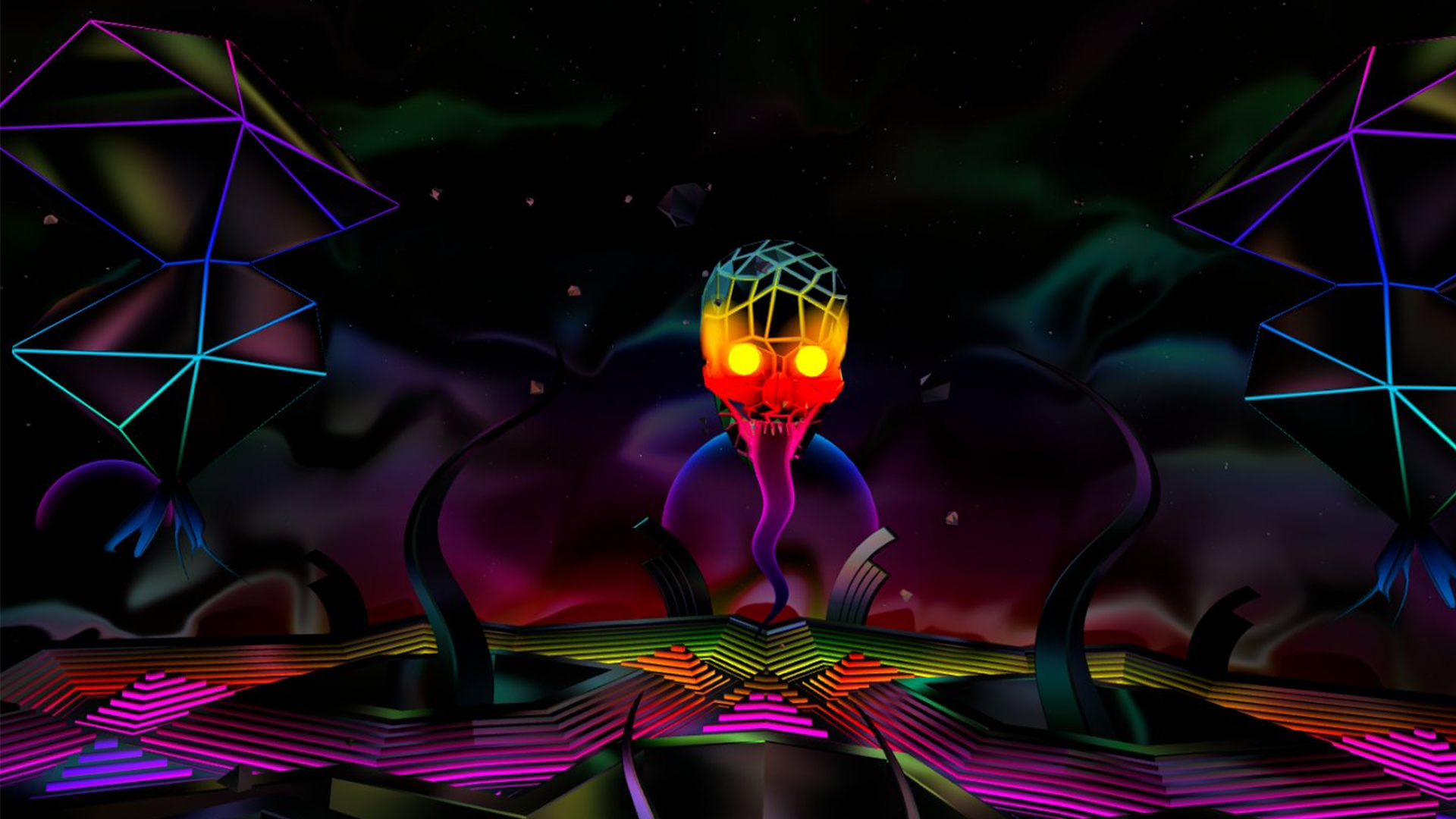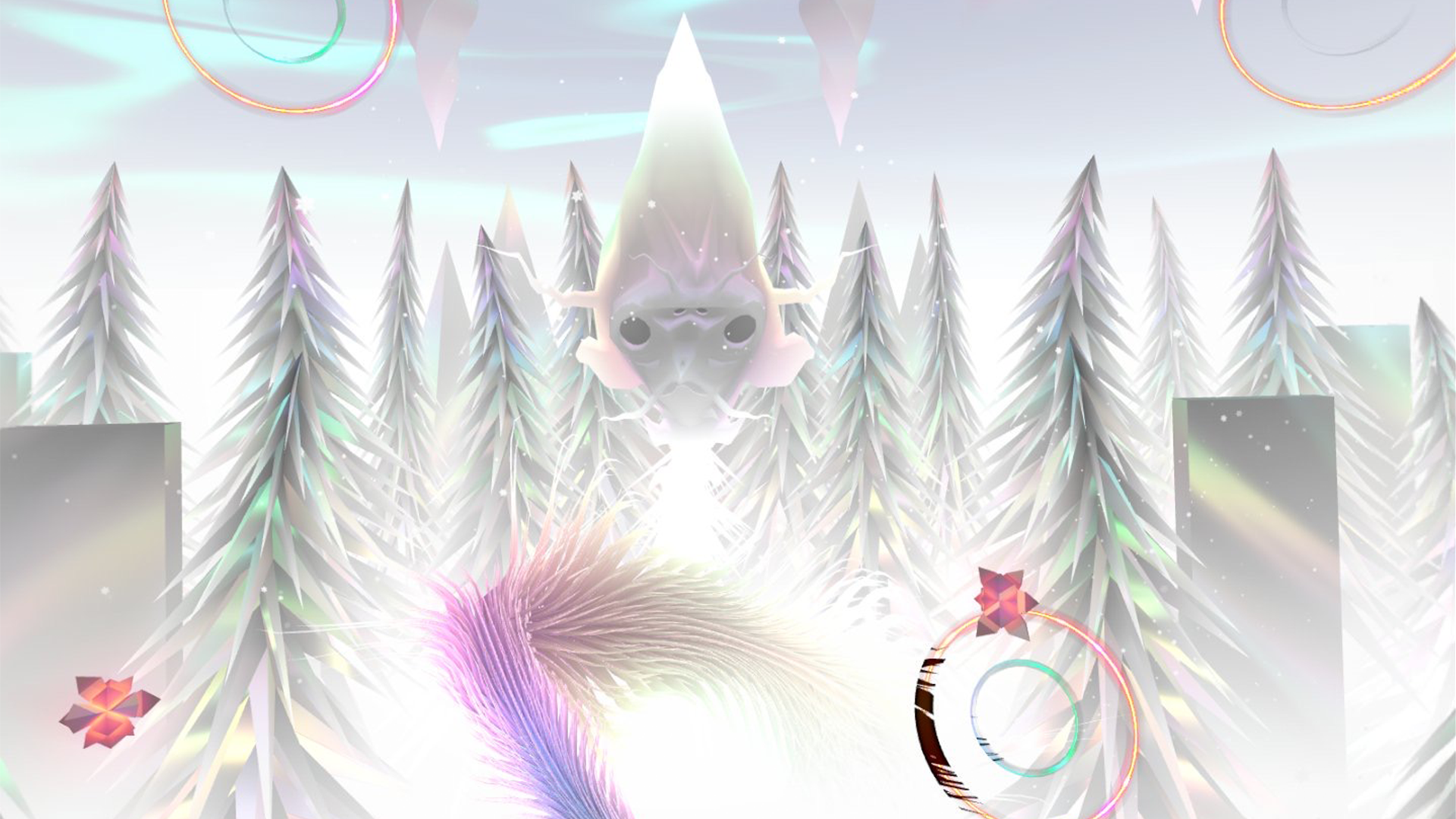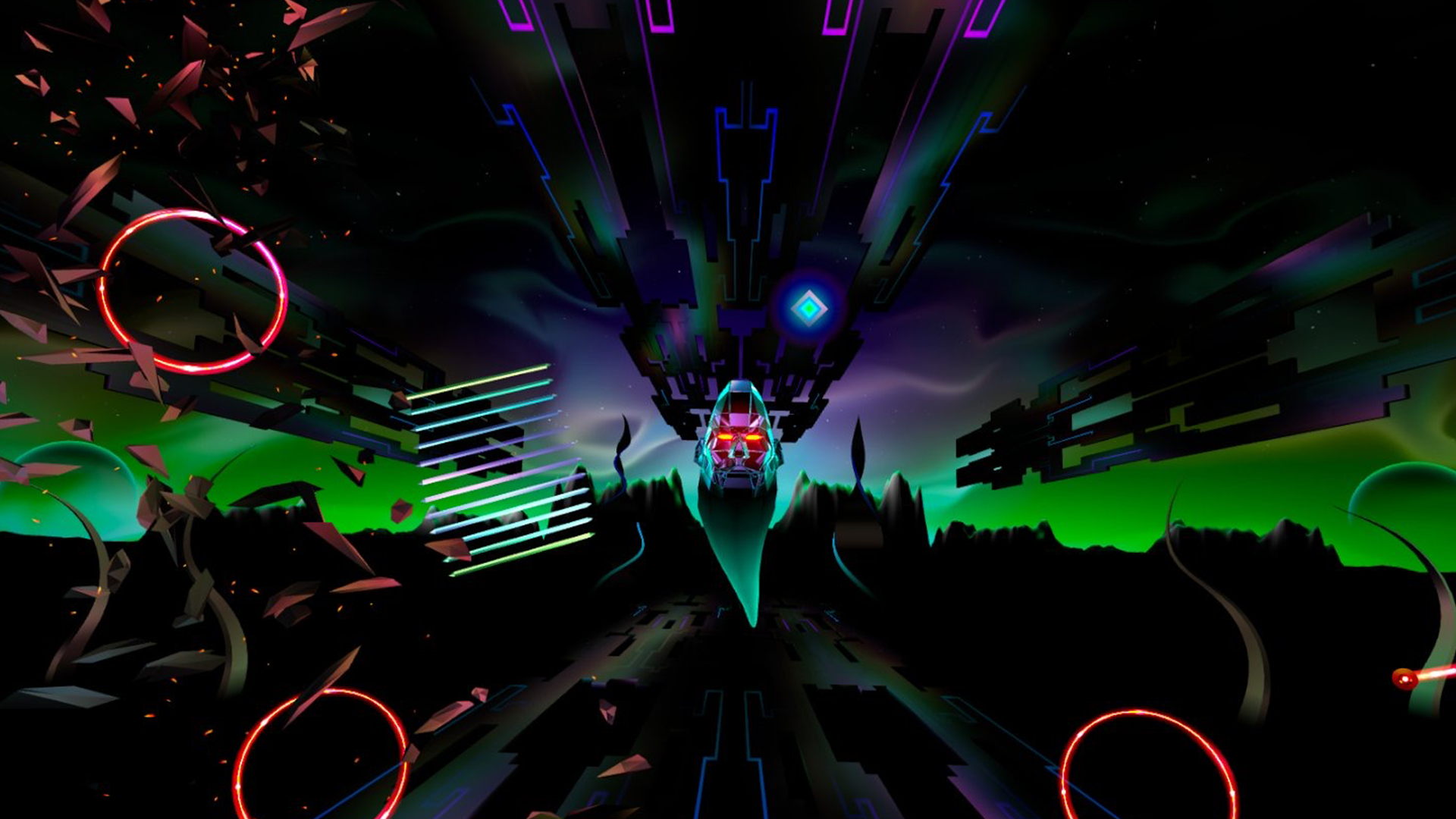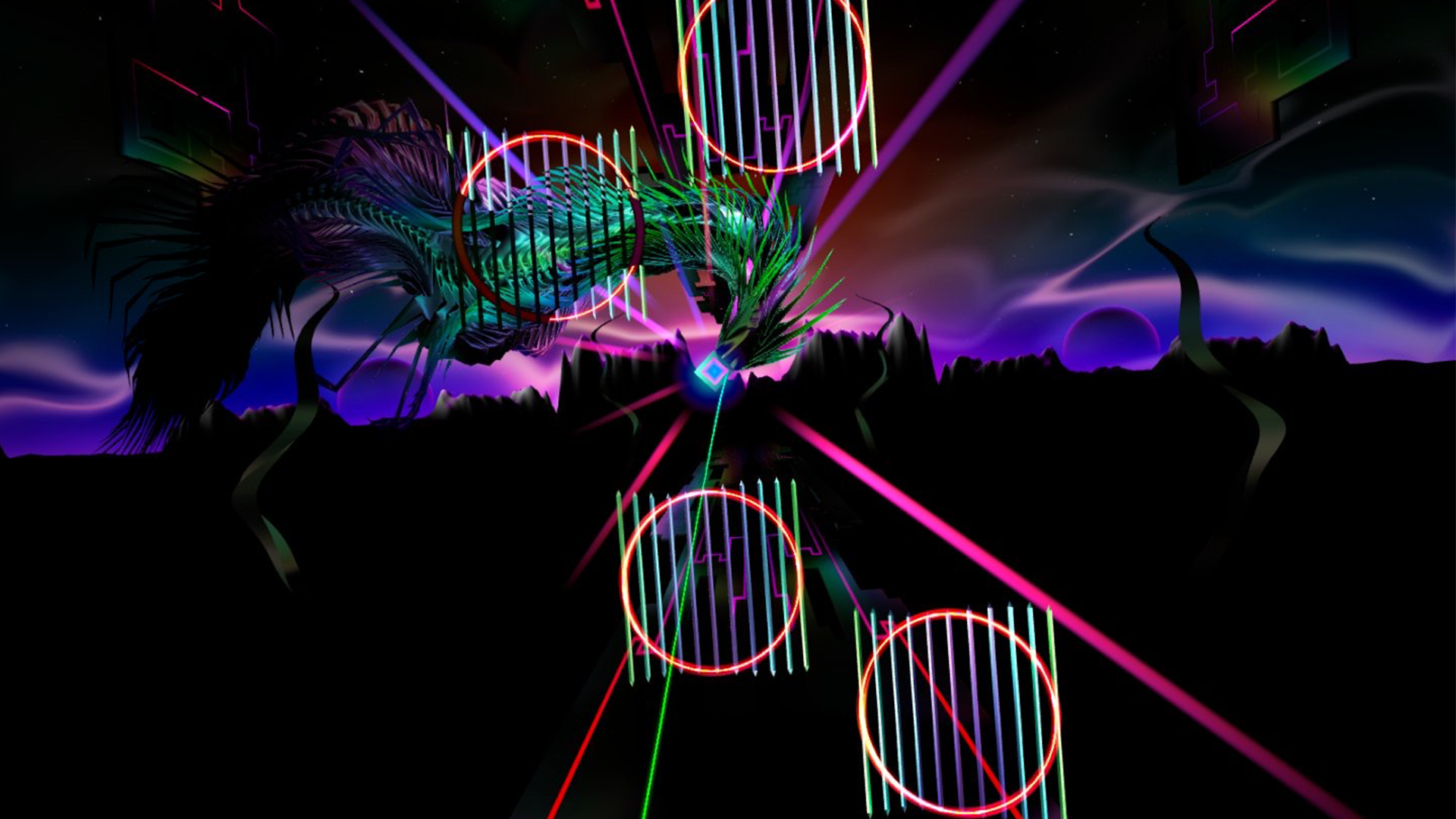Thrasher is an aesthetically abstract puzzler with a superb soundtrack, though some technical hiccups hinder its success. Read on for our full review.
The first time I failed a level in Thrasher, a large part of me wanted to quit the game and sell my headset – an overreaction, perhaps, but one that felt completely reasonable at the time. Curiously, though, it wasn’t the difficulty or the idea that I might have to redo a marathon of challenges that got me hot under the collar; my competitive spirit seemed to be running on overdrive.
What is it?: A psychedelic rhythm puzzle game where you swipe at targets and avoid obstacles across a variety of changing levels.
Platforms: Quest, Apple Vision Pro (reviewed on Quest 3)
Release Date: July 25th (Quest, AVP), December 2024 (PC VR)
Developer: Puddle
Price: $19.99
It helps that Thrasher’s world is so abstract and intoxicating. A spiritual successor to the cult VR rhythm game Thumper, it harnesses a similar psychedelic design scheme, asking you to direct a prismatic eel through an onslaught of moving targets as the clock ticks down. A carousel of power-ups and penalties complexifies your attempts to hit your goal, creating a curious atmosphere that quickly gets under your skin.
There is no prologue or expository introductory cutscene to latch onto when starting Thrasher’s campaign. Instead, you’re presented with your ferrofluid eel and some basic targets to hit. Here, you can get a feel for the acrobatics your companion creature can perform, from deft directional dashes to graceful swooping motions that allow you to defeat its bullet hell enemies. Once you’ve tackled a few waves of slashable targets, a boss will appear, and you’ll continue swiping at obstacles until you can send damage their way. There isn’t much variation in this basic formula throughout the game, though the addition of new time-slowing and damage-increasing power-ups keeps me on my toes.

Provocative visuals and its eccentric atmosphere keep you trucking through its phantasmagorical levels, and it’s very convincing, for the most part. Each of the realms you visit has a strong visual identity, from craggy, angular mountaintops to white, wispy trees. The icing on the cake of each level is undoubtedly the boss creatures that inhabit the zones, Leviathans whose alien features are sure to appear in my nightmares for the foreseeable future. One particular foe I was happy to defeat featured brooding orbs for eyes, razor-sharp teeth, and an uncomfortably long tongue hanging from its slack-jawed expression. While not every boss you face is quite as upsetting, I have to credit the developers at Puddle for building a uniquely disturbing cast of villains.
Yet despite such a sinister and intriguing look, Thrasher’s lack of a distinct plot meant there wasn’t much to sink my teeth into beyond the immediate gameplay experience. In these moments, I couldn’t help but think about other esoteric rhythm games like Tetris Effect: Connected and Rez Infinite, which manage to weave a sense of narrative inside of rhythmic levels alongside intense puzzle mechanics. Still, if you can accept these limitations and take its evolutionary story at face value, it’s easy to get swept up in Thrasher’s mesmerizing flow. Its subtle themes of survival and rebirth seep through as your teensy space eel grows gradually from the shadowy frame of youth into a formidable beast as they crest each level’s checkpoint.
Once you’ve graduated into the midgame and start to understand the controls, Thrasher begins to feel like the 4D chess equivalent of a fairground buzz-wire game. However, it can often feel like you’re wielding a wonky probe. No matter how careful you try to be, hitting a time penalty feels like an inevitability rather than something you can skillfully avoid. As waves of new obstacles arrive and your eel companion grows in size, attempts at finding a graceful solution fly out the window. Considering how finicky some obstacle patterns are, Thrasher’s slightly clunky control scheme isn’t always up to the task. This issue was further compounded by some performance issues we noticed while playing on Quest 3. The screen would jitter and freeze when colliding with multiple objects or swiping too fast. While most of the time, I could recover quickly, I occasionally found myself unable to pull out of the manoeuvre, taking more penalties than I deserved.

Thankfully, if you do run into the same trouble, Thrasher has a surprisingly forgiving checkpoint system that allows you to get back to the level you were on within moments of failure. Plus, if you can’t get the hang of a particularly tough wave of obstacles, the countdown clock will become moot after a few failed attempts, allowing you to progress through that challenge at your own pace. In this way, Thrasher feels like a brutal but accessible game for those curious about VR without oversimplifying its puzzles for seasoned players who want to embrace a proper challenge.
Comfort
Thrasher’s levels are all played from a fixed perspective, so there is no need to choose a movement system. Unfortunately, there is no specific setting to switch between seated and standing, but you can play in either orientation by re-setting your position through your headset’s onboard systems. Thrasher’s eel protagonist is controlled by swiping your hand while it’s outstretched in front of you, and you’ll have a choice between playing with your left or right hand. You can also play using hand tracking or controllers, depending on your preference.
Above all other aspects in Thrasher, the real star, is, as expected, its transforming soundtrack, which shifts with the visual theming of each world. Some levels are laden with synthy guitar riffs and heart-pounding beats, whereas others lean into a softer, shimmering, and sugary sound, buffeted by electronic strings. There are some delightful hints of drum and bass hidden amongst the electronica, too.
The core soundtrack is further enhanced by Thrasher’s environmental sound effects, such as the xylophonic crashing that comes from gliding through a target or the devastating explosion that plays after bumping into a time-stealing obstacle. This auditory assault strikes a careful balance between overwhelming and harmonious, but it always amplifies the specific essence of each area.

The haptic feedback on the Quest 3’s controllers rumbled in unison with Thrasher’s brilliant sound effects, adding to the sensory drama of its cosmic situations. Yet even this affable amount of feedback didn’t feel like enough, especially when compared to other rhythm games like Tetris Effect that tinker with and elevate the haptics to help immerse you in the music. It would have been nice to see an option to boost the built-in feedback for players who are looking for a more transcendent experience, something that Thrasher is more than capable of.
Screenshots of Thrasher may give players a strong impression of its sharp and shiny aesthetics, but this is an experiential game at its core, and flatscreen representations can’t convey how rich it can feel when all of the mystical moving parts are set into motion. Herein marks the game’s key selling point. As long as you aren’t looking for airtight controls, the most engaging story, or haptics, there’s plenty to enjoy about Thrasher, and you can easily lose hours trying to crunch the numbers and top its leaderboards.
Thrasher – Final Verdict
Thrasher combines the exhilaration of chasing moving targets with a unique visual style and a superb soundtrack. Yet, unfortunately, its beaming esoteric personality is dulled by some technical hiccups that keep it from feeling like a total success. Regardless, Thrasher’s uncompromising vision and challenging but approachable gameplay are to be admired.

UploadVR uses a 5-Star rating system for our game reviews – you can read a breakdown of each star rating in our review guidelines.





